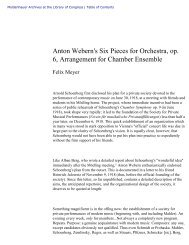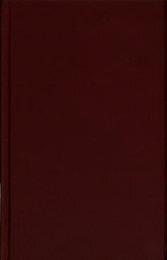Country Profile: Cuba - American Memory - Library of Congress
Country Profile: Cuba - American Memory - Library of Congress
Country Profile: Cuba - American Memory - Library of Congress
Create successful ePaper yourself
Turn your PDF publications into a flip-book with our unique Google optimized e-Paper software.
<strong>Library</strong> <strong>of</strong> <strong>Congress</strong> – Federal Research Division <strong>Country</strong> <strong>Pr<strong>of</strong>ile</strong>: <strong>Cuba</strong>, September 2006<br />
census, 75.9 percent <strong>of</strong> the total population was living in urban areas in cities ranging from<br />
20,000 inhabitants to 100,000 or more. The provinces with at least 1 million estimated<br />
inhabitants in 2004 were Ciudad de La Habana (City <strong>of</strong> Havana), with 2.8 million; Holguín, 1<br />
million; and Santiago de <strong>Cuba</strong>, 1 million. The country’s <strong>of</strong>ficial population density in 2003 was<br />
101.3 inhabitants per square kilometer, but that figure had risen to an estimated 102.4 inhabitants<br />
per square kilometer by 2006, ranking <strong>Cuba</strong> number 72 <strong>of</strong> 238 in a list <strong>of</strong> countries with the<br />
densest populations.<br />
Demography: Demographic indicators in 2006 included the following: a total fertility rate <strong>of</strong> an<br />
estimated 1.66 children born per woman, an estimated birthrate <strong>of</strong> 11.9 births per 1,000<br />
population, a general mortality rate <strong>of</strong> 6.22 per 1,000 population, a death rate <strong>of</strong> an estimated 7.2<br />
deaths per 1,000 population, and an infant mortality rate <strong>of</strong> 6.2 deaths per 1,000 live births.<br />
Deaths among children under five years <strong>of</strong> age (1.7 percent <strong>of</strong> all deaths) totaled 8.0 per 1,000<br />
live births in 2003. Life expectancy at birth in 2006 was an estimated 77.4 years: 75.1 years for<br />
men and 79.8 years for women. After two decades <strong>of</strong> sustained declines in fertility and mortality<br />
rates, in 2003 the country was showing a process <strong>of</strong> aging: 14.7 percent <strong>of</strong> inhabitants were aged<br />
60 or older, and persons under 15 years <strong>of</strong> age constituted only about 22 percent <strong>of</strong> the<br />
population. The average age <strong>of</strong> the population was 35.1. According to the 2002 census, the<br />
population is about equally divided between males and females.<br />
Ethnic Groups and Languages: A multiracial society, <strong>Cuba</strong> has a population <strong>of</strong> mainly Spanish<br />
and African origins; a majority <strong>of</strong> inhabitants, 51 percent, are mulatto or mestizo; 37 percent,<br />
white; and 11 percent, black. A small Chinese minority constitutes less than 1 percent <strong>of</strong> the total<br />
population. <strong>Cuba</strong> has two living languages. Spanish (Español) is the <strong>of</strong>ficial and dominant<br />
language. Lucumí is an ethnic language with Niger–Congo, Atlantic–Congo, Volta–Congo,<br />
Benue–Congo, Defoid, Yoruboid, and Edekiri roots.<br />
Religion: <strong>Cuba</strong> has no <strong>of</strong>ficial religion and is <strong>of</strong>ficially a secular state. In 1991 the Communist<br />
Party <strong>of</strong> <strong>Cuba</strong> (Partido Comunista de <strong>Cuba</strong>—PCC) lifted its prohibition against religious<br />
believers seeking membership, and a year later the constitution was amended to characterize the<br />
state as secular rather than atheist. Nevertheless, the government, through the Ministry <strong>of</strong><br />
Interior’s Office <strong>of</strong> Religious Affairs, restricts religious freedom. Although state restrictions<br />
apply to the independent Roman Catholic Church, they are enforced mainly against unregistered<br />
religious groups.<br />
About 85 percent <strong>of</strong> the population was nominally Roman Catholic before Fidel Castro seized<br />
power. Although Roman Catholicism continues to be the largest organized religion, after more<br />
than four decades <strong>of</strong> an atheist regime, most young people are not religious, nor do they have any<br />
religious training. At the time <strong>of</strong> the Revolution, there were also small Protestant minorities, and<br />
Evangelical Protestant denominations have continued to grow rapidly. A small and dwindling<br />
Jewish community remains as well. Afro-Christian rites are widely practiced by <strong>Cuba</strong>ns <strong>of</strong> all<br />
races, but primarily blacks and mulattoes. The Lucumí rite, or Santería, is a religion originating<br />
in West African Yoruba culture. It remains widespread in <strong>Cuba</strong> regardless <strong>of</strong> people’s nominal<br />
religious affiliation and state efforts to suppress it.<br />
8



![Albert Einstein Papers [finding aid]. Library of Congress. [PDF ...](https://img.yumpu.com/21604228/1/190x245/albert-einstein-papers-finding-aid-library-of-congress-pdf-.jpg?quality=85)





![American Colony in Jerusalem Collection [finding aid]. Library of ...](https://img.yumpu.com/17941275/1/190x245/american-colony-in-jerusalem-collection-finding-aid-library-of-.jpg?quality=85)



![Piccard Family Papers [finding aid]. - American Memory - Library of ...](https://img.yumpu.com/17941234/1/190x245/piccard-family-papers-finding-aid-american-memory-library-of-.jpg?quality=85)


